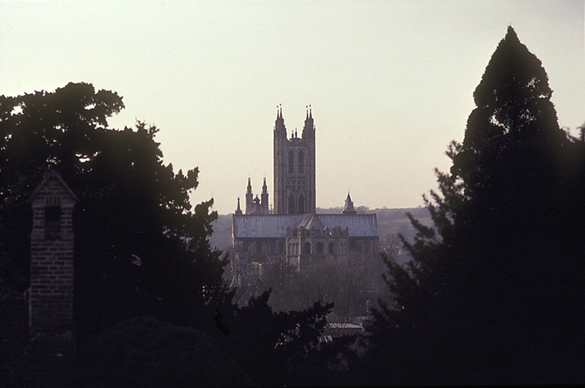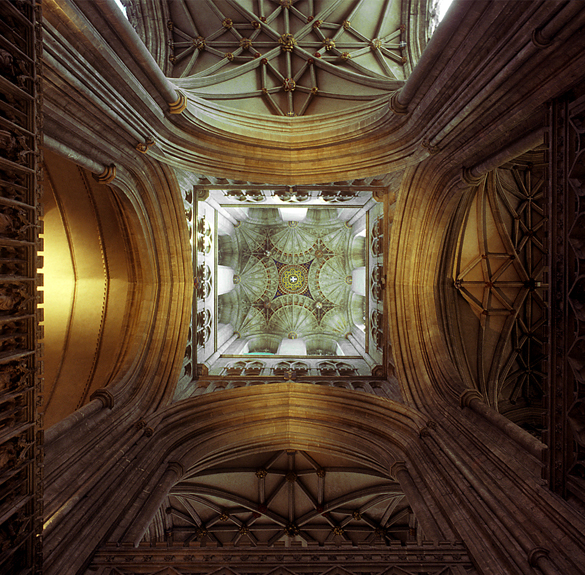
Canterbury Cathedral, from the east.
January was an insanely busy month for me, and whenever things get crazy I console myself with thoughts of the buildings that have had a big impact on me – the ones that made me want to be an architectural historian in the first place. These places keep me sane, so I thought I owed them at least a few blog entries.
I’m starting with Canterbury Cathedral, a building that literally changed my life. I took my first-ever trip abroad shortly after finishing my BA, and London was my first port of call. After an eye-opening three weeks there, I hit the road with a Britrail pass, and my first destination was Canterbury. I had read a bit about Canterbury, and seen the movie Becket; I knew it had a famous and historic cathedral, so it seemed the ideal place to start my journey into English history.

Thomas Becket, Archbishop, saint, and martyr – and main character in the Oscar-winning 1964 film named after him. He is depicted here in a thirteenth-century stained glass window in Canterbury Cathedral
Being an absolute rookie traveler, my big anxiety on the train ride from London to Canterbury was that I would miss my stop. Stations were not announced, and the train never stopped for long, so I realized I’d have to gather myself and my things up pretty swiftly when the time came or I could end up in Dover – surely the very end of the earth – by mistake.
So, every time the train slowed down, I nervously scanned the landscape for any indication of where I was. I figured that Canterbury had a cathedral, and that landmark was probably the thing to look for. Problem was, I didn’t know what it looked like. And as pretty much every town that we passed through had a medieval church of some sort, I kept spotting towers and spires in the distance, and wondering “is that it? Is that one it? Surely this must be it!”
After I don’t know how many false starts, the train slowed again, I looked out the window… and this time there was not the slightest possibility of doubt. I saw something so big, so beautiful, so utterly awe-inspiring, that I instantly knew this was IT. I could not believe that something so dazzling existed. This was what I had come for.

Canterbury Cathedral from the campus of the University of Kent, one of the few places from which it can be seen in its entirety.
Thanks to Richard Burton and Peter O’Toole (Becket, Paramount Pictures, 1964), I had some sense of the historical importance of the cathedral. I knew that Thomas Becket had been Henry II’s close friend, and that they’d fallen out after the former’s appointment of the latter as Archbishop of Canterbury, and that Henry’s men finally murdered Becket right inside his own cathedral on December 29, 1170. Following in the footsteps of the characters of this historical drama added to the thrill of being there. I got to gaze upon the spot where Thomas fell, visit the crypt where Henry had been flogged by the monks in penance for the murder, and see the lone candle marking the spot where Becket’s shrine stood for over three hundred years until it was destroyed under orders from Henry VIII. It set my historical imagination on fire, and the flame has never gone out.

The Altar of the Sword’s Point, marking the site of Becket’s murder.

A candle marks the spot where Becket’s shrine stood from 1220-1538
I didn’t know it at the time, but the course of my life had changed. I studied other things, and had a whole other career, but from the moment I spotted Canterbury Cathedral through the train window it was inevitable that I would, eventually, put my new-found passion for history and historic buildings at the centre of my life. And now here I am, over thirty years later, with the best job in the world.
See why I encourage students to study abroad?

The Bell Harry Tower, a jeweled shrine within and a beacon to pilgrims without.